CONFIDENCE.NORM function - The function returns the confidence interval of the population by using a normalized distribution in Excel
The following article introduces you to CONFIDENCE.NORM - one of the functions in the group of statistical functions that is very popular in Excel.

Description: The function returns the confidence interval for the population by using normalized distributions. Support functions from Excel 2010 onwards.
Syntax: CONFIDENCE.NORM (alpha, standard_dev, size)
Inside:
- alpha: The critical level to calculate the confidence level, with confidence level = 100 * (1- alpha) , is the required parameter .
- standard_dev: The overall standard deviation for the data range, and considered to have been determined, is the required parameter.
- size: Sample size , is a required parameter.
Attention:
- If any of the parameters' values are not numeric -> the function returns the #VALUE! Error value .
- If alpha ≤ 0 or alpha ≥ 1 -> the function returns the #NUM! Error value
- If standard_dev ≤ 0 -> the function returns the #NUM! Error value
- If size is not an integer -> it is truncated to an integer.
- If size ≤ 1 -> the function returns the #NUM! Error value
- If deg_freedom <1 or deg_freedom> 10 ^ 10 -> the function returns the #NUM! Error value
- Assuming alpha = 0.5 -> confidence interval is:
[overline chi pm 1.96left ({frac {sigma} {{sqrt n}}} right)]
For example:
Calculate the average overall confidence interval with the data in the table below:
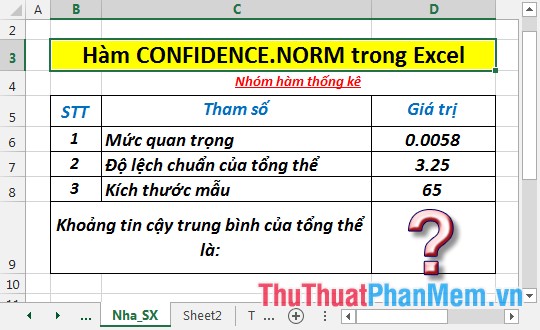
- In the cell to calculate, enter the formula: = CONFIDENCE.NORM (D6, D7, D8)
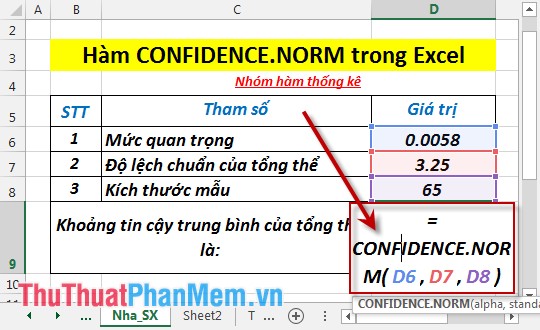
- Press Enter -> the overall confidence interval for the population is:
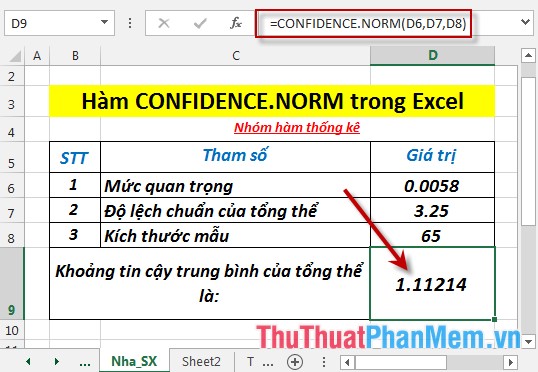
- Where alpha ≤ 0 or alpha ≥ 1 -> the function returns the #NUM! Error value
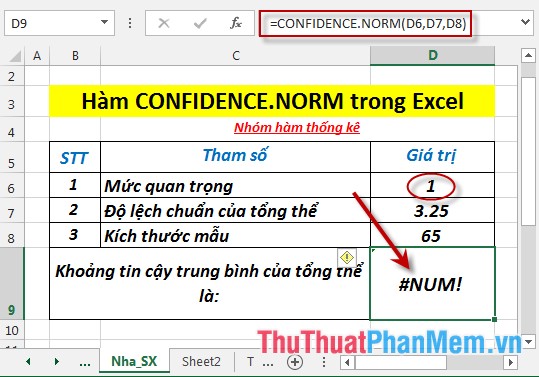
- Where size ≤ 1 -> the function returns the #NUM! Error value
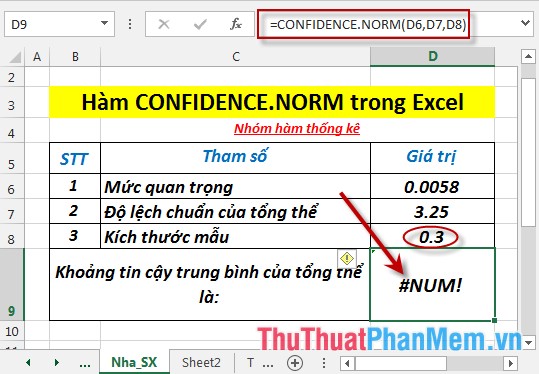
Above are instructions and some specific examples when using the CONFIDENCE.NORM function in Excel.
Good luck!
You should read it
- NORM.S.INV function - The function returns the inverse of the normalized distribution with an average value of 0 and a standard deviation of 1 in Excel
- GUSSE function - The function returns the probability that an element of the population is normalized in Excel
- NORM.INV function - The function returns the inverse of the standard cumulative distribution in Excel
- NORM.DIST function - The function returns the normal distribution with the standard deviation and the mean value specified in Excel
- STANDARDIZE function - The function returns the normalized value from a specific distribution in Excel
- WEIBULL function - The function returns the Weibull distribution in Excel
- To be confident immediately apply the following 5 tips
- GAMMA.INV function - The function returns the inverse of the gamma distribution in Excel
May be interested
- How to use the NORMDIST function in Excel - Function that returns the distribution in Excel
 the normdist function returns a distribution with a specified mean and standard deviation. the normdist function has applications in statistics, including hypothesis testing.
the normdist function returns a distribution with a specified mean and standard deviation. the normdist function has applications in statistics, including hypothesis testing. - BETA.DIST function - The function returns the Beta distribution in Excel
 beta.dist function: the function returns the beta distribution to study the variability of a number of things through a sample. support functions from excel 2010 onwards. syntax: beta.dist (x, alpha, beta, cumulative, [a], [b])
beta.dist function: the function returns the beta distribution to study the variability of a number of things through a sample. support functions from excel 2010 onwards. syntax: beta.dist (x, alpha, beta, cumulative, [a], [b]) - POISSON function - The function returns the Poisson distribution in Excel
 in predicting the number of events that occur within a specific time, one cannot help but use the poisson function. the following article details how to use the poisson function, the function returns the poisson distribution.
in predicting the number of events that occur within a specific time, one cannot help but use the poisson function. the following article details how to use the poisson function, the function returns the poisson distribution. - BETA.INV function - The function returns the inverse of the cumulative distribution function for a specified beta distribution in Excel
 beta.inv function: the function returns the inverse of the cumulative distribution function for a specified beta distribution. support functions from excel 2010 version. syntax: beta.inv (probability, alpha, beta, [a], [b])
beta.inv function: the function returns the inverse of the cumulative distribution function for a specified beta distribution. support functions from excel 2010 version. syntax: beta.inv (probability, alpha, beta, [a], [b]) - PHI function - The function returns the value of the density function for a normal distribution in Excel
 phi function: the function returns the value of the density function for a standard normal distribution. support functions from excel 2013 onwards. syntax: phi (x)
phi function: the function returns the value of the density function for a standard normal distribution. support functions from excel 2013 onwards. syntax: phi (x) - LOGNORM.INV function - The function returns the inverse of the logarithmic distribution of x in Excel
 lognorm.inv: the function returns the inverse of the logarithmic distribution of x. where ln (x) is usually distributed with parameter mean and standard deviation. use functions to analyze logarithmic change data. support function from excel 2 version
lognorm.inv: the function returns the inverse of the logarithmic distribution of x. where ln (x) is usually distributed with parameter mean and standard deviation. use functions to analyze logarithmic change data. support function from excel 2 version - T.INV function - The function returns the inverse value of the Student t distribution in Excel
 t.inv: the function returns the inverse value of the student t-distribution. support functions from excel 2010 onwards. syntax: t.inv (probability, deg_freedom)
t.inv: the function returns the inverse value of the student t-distribution. support functions from excel 2010 onwards. syntax: t.inv (probability, deg_freedom) - T.DIST.RT - The function returns the Student's t-distribution on the right in Excel
 t.dist.rt: the function returns the student's t-distribution on the right. functions used in testing the hypothesis of small numbers of data sets. support functions from excel 2010 onwards. syntax: t.dist.rt (x, deg_freedom)
t.dist.rt: the function returns the student's t-distribution on the right. functions used in testing the hypothesis of small numbers of data sets. support functions from excel 2010 onwards. syntax: t.dist.rt (x, deg_freedom) - F.DIST - The function returns the probability distribution F in Excel
 f.dist function: the function returns the probability distribution f. the function supports the version from excel 2010. syntax: f.dist (x, deg_freedom1, deg_freedom2, cumulative)
f.dist function: the function returns the probability distribution f. the function supports the version from excel 2010. syntax: f.dist (x, deg_freedom1, deg_freedom2, cumulative) - HYPGEOM.DIST - The function returns the hyperbolic distribution in Excel
 hypgeom.dist: the function returns the hyperinfection distribution, using this function for problems with finite sets of vowismooix observations whether or not they are successful. syntax: hypgeom.dist (sample_s, number_sample, population_s, number_pop, cumulative)
hypgeom.dist: the function returns the hyperinfection distribution, using this function for problems with finite sets of vowismooix observations whether or not they are successful. syntax: hypgeom.dist (sample_s, number_sample, population_s, number_pop, cumulative)










 TODAY function - The function returns the current date value in the format in Excel
TODAY function - The function returns the current date value in the format in Excel WEEKDAY function - The function returns the weekday of a corresponding date in Excel
WEEKDAY function - The function returns the weekday of a corresponding date in Excel WEEKNUM function - The function returns the week number of the year in Excel
WEEKNUM function - The function returns the week number of the year in Excel The WORKDAY function - The function returns a date before or after the start date of a number of working days in Excel
The WORKDAY function - The function returns a date before or after the start date of a number of working days in Excel The WORKDAY.INTL function - The function returns a date before or after the date starting with a custom weekend in Excel
The WORKDAY.INTL function - The function returns a date before or after the date starting with a custom weekend in Excel YEAR - The function returns the year corresponding to a date in Excel
YEAR - The function returns the year corresponding to a date in Excel